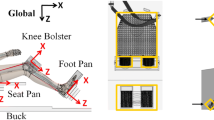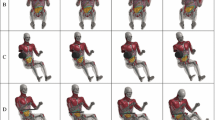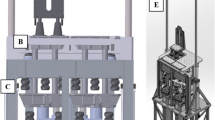Abstract
A goal of the Human Research Program at National Aeronautics and Space Administration (NASA) is to analyze and mitigate the risk of occupant injury due to dynamic loads. Experimental tests of human subjects and biofidelic anthropomorphic test devices provide valuable kinematic and kinetic data related to injury risk exposure. However, these experiments are expensive and time consuming compared to computational simulations of similar impact events. This study aimed to simulate human volunteer biodynamic response to unidirectional accelerative loading. Data from seven experimental studies involving 212 volunteer tests performed at the Air Force Research Laboratory were used to reconstruct 13 unique loading conditions across four different loading directions using finite element human body model (HBM) simulations. Acceleration pulses and boundary conditions from the experimental tests were applied to the Global Human Body Models Consortium (GHBMC) simplified 50th percentile male occupant (M50-OS) using the LS-Dyna finite element solver. Head acceleration, chest acceleration, and seat belt force traces were compared between the experimental and matched simulation signals using correlation and analysis (CORA) software and averaged into a comprehensive response score ranging from 0 to 1 with 1 representing a perfect match. The mean comprehensive response scores were 0.689 ± 0.018 (mean ± 1 standard deviation) in two frontal simulations, 0.683 ± 0.060 in four rear simulations, 0.676 ± 0.043 in five lateral simulations, and 0.774 ± 0.013 in two vertical simulations. The CORA scores for head and chest accelerations in these simulations exceeded mean scores reported in the original development and validation of the GHBMC M50-OS model. Collectively, the CORA scores indicated that the HBM in these boundary conditions closely replicated the kinematics of the human volunteers across all loading directions.








Similar content being viewed by others
References
Adams, G. R., V. J. Caiozzo, and K. M. Baldwin. Skeletal muscle unweighting: spaceflight and ground-based models. J. Appl. Physiol. 95(2185–2201):2003, 1985.
Buhrman, J. The AFRL Biodynamics Data Bank and Modeling Applications. Dayton: RTO Meeting, 1998.
Caldwell, E., M. Gernhardt, J. Somers, D. Younker, and N. Newby. NASA Evidence Report: Risk of Injury due to Dynamic Loads. Houston, TX: National Aeronautics and Space Administration, Lyndon B. Johnson Space Center, 2012.
Currie-Gregg, N. J., M. L. Gernhardt, C. Lawrence, and J. T. Somers. Crew Exploration Vehicle (CEV) (Orion) Occupant Protection. 2016.
Danelson K. A., A. R. Kemper, M. J. Mason, M. Tegtmeyer, S. A. Swiatkowski, J. H. Bolte IV, and W. N. Hardy. Comparison of ATD to PMHS response in the under-body blast environment. SAE Technical Paper, 2015.
Davis, M. L., and F. S. Gayzik. An Objective Evaluation of Mass Scaling Techniques Utilizing Computational Human Body Finite Element Models. J. Biomech. Eng. 138:101003, 2016.
Decker, W., B. Koya, M. L. Davis, and F. S. Gayzik. Modular use of human body models of varying levels of complexity: Validation of head kinematics. Traffic Inj. Prev. 18:S155–S160, 2017.
Doczy, E., S. Mosher, and J. Buhrman. The effects of variable helmet weight and subject bracing on neck loading during frontal-G x impact. Dayton, OH: General Dynamics Advanced Information Systems, 2004.
Eppinger R. H. Prediction of thoracic injury using measurable experimental parameters. Proceedings of the International Conference of Experimental Safety Vehicles, NHTSA, Washington, DC, 1976, pp. 770–780.
Gayzik, F., I. Marcus, K. Danelson, J. Rupp, C. Bass, N. Yoganandan, and J. Zhang. A point-wise normalization method for development of biofidelity response corridors. J. Biomech. 48:4173–4177, 2015.
Gayzik, F., D. Moreno, K. Danelson, C. McNally, K. Klinich, and J. D. Stitzel. External landmark, body surface, and volume data of a mid-sized male in seated and standing postures. Ann. Biomed. Eng. 40:2019–2032, 2012.
Gayzik, F., D. Moreno, C. Geer, S. Wuertzer, R. Martin, and J. Stitzel. Development of a full body CAD dataset for computational modeling: a multi-modality approach. Ann. Biomed. Eng. 39:2568, 2011.
Gehre C., H. Gades, and P. Wernicke. Objective rating of signals using test and simulation responses. Proceedings of the 21st International Technical Conference on the Enhanced Safety of Vehicles, Stuttgart, Germany, 2009.
Hearon B. F. and J. W. Brinkley. Comparison of human impact response in restraint systems with and without a negative G strap. DTIC Document, 1986.
Hill D., T. Knox, and D. Crockett. Monitoring race car drivers using helmet and head-mounted sensors. SAE Technical Paper, 2000.
Jones R. Landing impact attenuation for non-surface-planing landers. 1970.
Killian, J., and H. F. Boedecker. Whole Body Response—Lateral: Comparison Between Human and Dummy Subjects Utilizing a Nine Transducer Accelerometer Package. Dayton: Wright-Patterson Air Force Base, OH: Aerospace Medical Research Laboratory, 1981.
Lang, T., A. LeBlanc, H. Evans, Y. Lu, H. Genant, and A. Yu. Cortical and trabecular bone mineral loss from the spine and hip in long-duration spaceflight. J. Bone Miner. Res. 19:1006–1012, 2004.
Mertz, H. J., A. L. Irwin, and P. Prasad. Biomechanical and scaling bases for frontal and side impact injury assessment reference values. Stapp Car Crash J. 47:155, 2003.
Park G., T. Kim, J. R. Crandall, C. Arregui Dalmases, and L. Narro. Comparison of kinematics of GHBMC to PMHS on the side impact condition. Proceedings of the 2013 IRCOBI Conference, 2013, pp. 368–379.
Payne, P. R. Personnel Restraint and Support System Dynamics. Cincinnati: Frost Engineering Development Corp Denver Co, 1965.
Perry, C., and J. Buhrman. Effect of helmet inertial properties on head and neck response during + G z impact accelerations. J. Gravit. Physiol 2:P88–91, 1994.
Perry, C. E., and J. R. Buhrman. Effect of helmet inertial properties on the biodynamics of the head and neck during + G z impact accelerations. SAFE J. 26:34–41, 1996.
Perry C., J. Buhrman, E. Doczy, and S. Mosher. The effects of variable helmet weight on head response and neck loading during lateral + G y impact. Proceedings of the 41st Annual SAFE Symposium. Jacksonville, FL: 2003.
Russo D., T. Foley, K. Stroud, J. Connolly, B. Tillman, and L. Pickett. NASA space flight human system standards. Proceedings of the Human Factors and Ergonomics Society Annual Meeting, Sage Publications Sage CA: Los Angeles, CA, 2007, pp. 1468–1470.
Salerno M. D., J. W. Brinkley, and M. A. Orzech. Dynamic response of the human head to + G x impact. DTIC Document, 1987.
Salzar, R. S., J. R. Bolton, J. R. Crandall, G. R. Paskoff, and B. S. Shender. Ejection injury to the spine in small aviators: sled tests of manikins vs. post mortem specimens. Aviat. Space Environ. Med. 80:621–628, 2009.
Schwartz, D., B. Guleyupoglu, B. Koya, J. D. Stitzel, and F. S. Gayzik. Development of a computationally efficient full human body finite element model. Traf Injury Prev 16:S49–S56, 2015.
Somers J. T., and D. Gohmert. Application of the brinkley dynamic response criterion to spacecraft transient dynamic events. Technical Paper No. NASA/TM-2013-217380). United States: NASA. http://www.researchgate.net/publication/258207991_Application_of_the_Brinkley_Dynamic_Response_Model_to_Spacecraft_Transient_Events/file/504635273b3e8a8cf0.pdf, vehicle landing 2013.
Somers, J. T., N. J. Newby, C. Lawrence, R. L. DeWeese, D. Moorcroft, and S. E. Phelps. Investigation of the THOR anthropomorphic test device for predicting occupant injuries during spacecraft launch aborts and landing. Front. Bioeng. Biotechnol. 2:4, 2014.
Towns, J., T. Cockerill, M. Dahan, I. Foster, K. Gaither, A. Grimshaw, V. Hazlewood, S. Lathrop, D. Lifka, and G. D. Peterson. XSEDE: accelerating scientific discovery. Comput. Sci. Eng. 16:62–74, 2014.
Vavalle, N. A., M. L. Davis, J. D. Stitzel, and F. S. Gayzik. Quantitative validation of a human body finite element model using rigid body impacts. Ann. Biomed. Eng. 43:2163–2174, 2015.
Vavalle, N. A., D. P. Moreno, A. C. Rhyne, J. D. Stitzel, and F. S. Gayzik. Lateral impact validation of a geometrically accurate full body finite element model for blunt injury prediction. Ann. Biomed. Eng. 41:497–512, 2013.
Weis, E. B., N. P. Clarke, and J. W. Brinkley. Human response to several impact acceleration orientations and patterns. Wright-Patterson OH: Air Force Aerospace Medical Research Lab, 1963.
Acknowledgments
This study was supported by NASA Human Health and Performance Contract (HHPC) Award Number NNJ15HK11B through KBRwyle. Views expressed are those of the authors and do not represent the views of NASA or KBRwyle. Simulations were performed on the DEAC cluster at Wake Forest University. This work also used the Extreme Science and Engineering Discovery Environment (XSEDE), which is supported by National Science Foundation Grant Number OCI-1053575. Specifically, it used the Bridges system, which is supported by NSF Award Number ACI-1445606, at the Pittsburgh Supercomputing Center (PSC).31
Conflict of interest
Dr. Stitzel and Dr. Gayzik are members of Elemance, LLC, which provides academic and commercial licenses of the GHBMC-owned human body computer models.
Author information
Authors and Affiliations
Corresponding author
Additional information
Associate Editor Stefan M. Duma oversaw the review of this article.
Appendices
Appendix A: Human Volunteer Characteristics by Loading Condition
Appendix B: Foam Material Properties for Head Rest and Side Guard Cushions
Expected Base Units: kg, mm, ms, kN
LS-Dyna Material Model: Low Density Foam
Appendix C: Input Acceleration Pulses

Appendix D: CORA Score Generation Parameters
Parameters for CORA version 3.5.1.
Global settings to define the interval of evaluation
A_THRES | 0.03 | Threshold to set the start of the interval of evaluation [0,…,1] |
B_THRES | 0.075 | Threshold to set the end of the interval of evaluation [0,…,1] |
A_EVAL | 0.01 | Extension of the interval of evaluation [0,…,1] |
B_DELTA_END | 0.2 | Additional parameter to shorten the interval of evaluation (width of the corridor: A_DELTA_END*Y_NORM) 0 = disabled |
T_MIN | 0 | Manually defined start (time) and end (time) of the interval of evaluation (automatic = calculated for each channel) |
T_MAX | 200 |
Global settings of the corridor method
G_1 | 0.5 | Weighting factor of the corridor method |
K | 2 | Transition between ratings of 1 and 0 of the corridor method (1 = linear, 2 = quadratic …) |
Global settings of the cross correlation method
G_2 | 0.5 | Weighting factors of the cross correlation method |
D_MIN | 0.05 | delta_min as share of the interval of evaluation [0,…,1] |
D_MAX | 0.15 | delta_max as share of the interval of evaluation [0,…,1] |
INT_MIN | 0.8 | Minimum overlap of the interval [0,…,1] |
K_V | 10 | Transition between ratings of 1 and 0 of the progression rating (1 = linear, 2 = quadratic …) |
K_G | 1 | Transition between ratings of 1 and 0 of the size rating (1 = linear, 2 = quadratic …) |
K_P | 1 | Transition between ratings of 1 and 0 of the phase shift rating (1 = linear, 2 = quadratic …) |
G_V | 0.50 | Weighting factors of the progression rating |
G_G | 0.25 | Weighting factors of the size rating |
G_P | 0.25 | Weighting factors of the phase shift rating |
Appendix E: Graphical CORA Comparisons by Loading Configuration
See Figs. E1, E2, E3, E4, E5, E6, E7, E8, E9, E10, E11, E12, and E13.

Appendix F: Corridor Difficulty Scores (CDS)
See Fig. F1.
Rights and permissions
About this article
Cite this article
Gaewsky, J.P., Jones, D.A., Ye, X. et al. Modeling Human Volunteers in Multidirectional, Uni-axial Sled Tests Using a Finite Element Human Body Model. Ann Biomed Eng 47, 487–511 (2019). https://doi.org/10.1007/s10439-018-02147-3
Received:
Accepted:
Published:
Issue Date:
DOI: https://doi.org/10.1007/s10439-018-02147-3
























